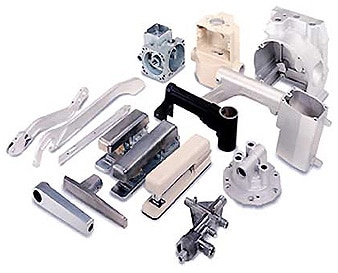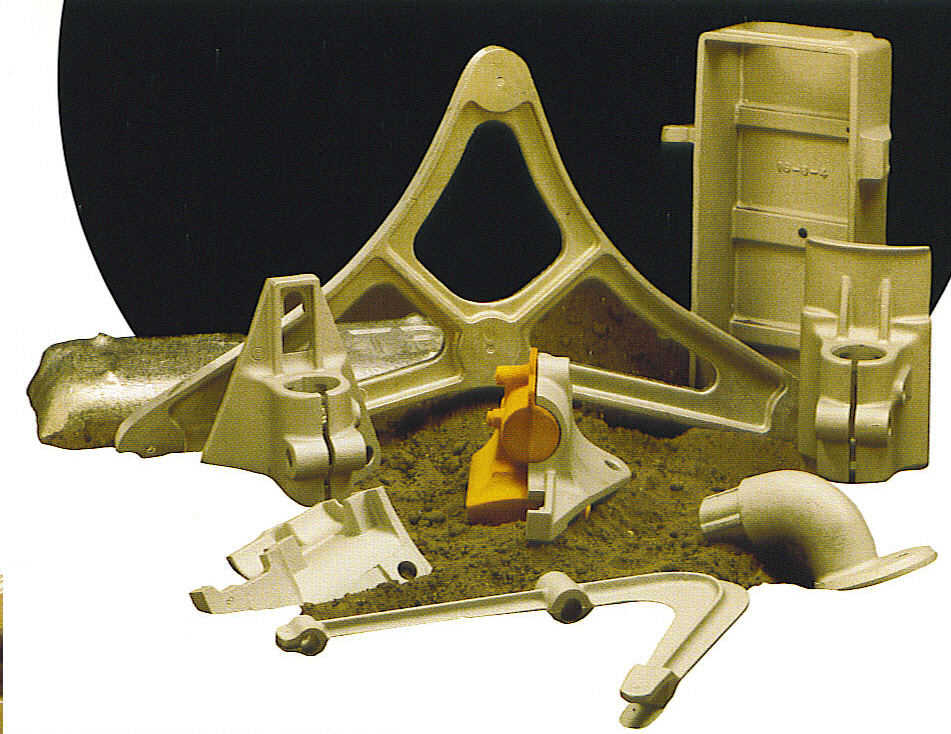Why Aluminum Castings are crucial for industrial applications
Discovering the Perks and Practical Uses of Light Weight Aluminum Castings in Today's Market
Aluminum spreadings have become increasingly pertinent in different sectors because of their one-of-a-kind qualities. Their light-weight nature and resistance to rust make them ideal for requiring applications. Additionally, the premium strength-to-weight ratio uses significant advantages in layout and manufacturing. As markets proceed to explore their possibility, the full range of aluminum spreadings' applications and advantages stays to be completely uncovered. What lies in advance for this versatile material?
The Lightweight Benefit of Aluminum Castings
Lots of products are utilized in production, aluminum spreadings stand out largely due to their light-weight homes. This particular makes light weight aluminum castings an eye-catching choice for different markets, especially in aerospace and auto applications, where weight reduction is crucial for enhancing gas performance and performance. The lightweight nature of light weight aluminum permits suppliers to develop parts that are much easier to install and handle, ultimately reducing labor costs.
Additionally, the ability to produce complex shapes without considerable weight charges allows designers to innovate while preserving structural honesty. Aluminum castings can properly change much heavier materials, resulting in significant savings in delivery and functional expenses. Their lightweight advantage likewise adds to boosted item longevity, as lighter components typically bring about minimized wear and tear on equipment. In general, the lightweight properties of aluminum spreadings give suppliers with an one-upmanship, fostering developments in item style and performance throughout numerous sectors.

Remarkable Deterioration Resistance
Light weight aluminum castings possess a natural resistance to oxidation, which substantially improves their longevity in various environments. This fundamental residential or commercial property not just adds to their toughness yet also aligns with the lightweight advantage that aluminum uses. Consequently, light weight aluminum castings are significantly recognized for their extraordinary corrosion resistance in countless applications.

Naturally Immune to Oxidation
Among the standout characteristics of light weight aluminum castings is their exceptional rust resistance, which originates from a natural oxidation procedure. When exposed to air, light weight aluminum reacts to form a slim, safety layer of aluminum oxide. This layer acts as an obstacle against further oxidation and shields the underlying metal from harsh aspects such as moisture and salts. Unlike various other metals, this oxide layer is self-repairing; if harmed, it swiftly reforms when revealed to air. This special residential property enhances the long life of aluminum spreadings in various settings, making them suitable for applications in industries such as aerospace, vehicle, and marine. The all-natural resistance to oxidation significantly minimizes maintenance prices and increases the integrity of aluminum castings in demanding problems.
Light-weight Sturdiness Benefit
The lightweight nature of aluminum castings contributes substantially to their sturdiness, making them an advantageous option in different markets. This extraordinary toughness is mostly connected to aluminum's inherent resistance to deterioration, which is boosted better via anodizing and various other surface area treatments. Unlike lots of metals, light weight aluminum does not corrosion; instead, it develops a safety oxide layer that guards it from ecological damage. This building is particularly advantageous in sectors such as automobile and aerospace, where weight reduction is essential without jeopardizing toughness. In addition, the durability of aluminum castings decreases upkeep costs and substitutes, providing financial benefits over time. Subsequently, their lightweight longevity and corrosion resistance position light weight aluminum spreadings as a premium product for contemporary production applications.
Superior Strength-to-Weight Ratio
An amazing attribute of aluminum spreadings is their remarkable strength-to-weight proportion, that makes them very desirable in numerous applications. This intrinsic residential or commercial property enables light weight aluminum spreadings to endure considerable tension while remaining lightweight, a critical consider sectors such as aerospace, vehicle, and manufacturing. Engineers often like aluminum spreadings for elements that require both toughness and minimized weight, improving gas efficiency and performance.
The high strength-to-weight ratio also promotes the style of intricate shapes and structures, making light weight aluminum castings flexible for facility applications. The ability to preserve architectural stability under tough problems warranties long life and reliability in products, from airplane frames to vehicle components. This advantage adds to the expanding pattern of utilizing aluminum castings in innovative styles, inevitably leading to enhanced performance and efficiency throughout varied fields. As a result, the remarkable strength-to-weight proportion of light weight aluminum spreadings positions them as an essential product in modern design and production.
Cost-Effectiveness in Production
Cost-effectiveness in aluminum spreading manufacturing is mostly attained via decreased material waste and effective production procedures. By optimizing designs and utilizing sophisticated strategies, makers can reduce excess material use while preserving high quality requirements. This method not just decreases production expenses but also adds to more sustainable methods within the market.
Lowered Material Waste
Reducing material waste in light weight aluminum spreading procedures greatly enhances manufacturing performance. By enhancing the style and production methods, business can minimize excess scrap and boost source utilization. This reduction in waste not only reduces product costs yet likewise adds to an extra sustainable production design. The capacity to recycle light weight aluminum additional supports cost-effectiveness, enabling suppliers to redeem and reuse products without jeopardizing high quality. As the market progressively concentrates on sustainability, minimized product waste straightens with ecological goals while all at once boosting earnings. Eventually, effective use raw products strengthens the affordable setting of services on the market, making aluminum spreadings a desirable alternative in resource various applications. The critical strategy to minimizing waste shows a commitment to both environmental and economic obligation.
Effective Manufacturing Processes
While typical production processes can incur considerable expenses, light weight aluminum spreading uses a more efficient option that enhances total production profitability. This technique reduces material waste and permits for precise control over the manufacturing process, bring about lowered labor and functional prices. The ability to create complicated forms with fewer actions better streamlines manufacturing, adding to shorter preparations. Furthermore, light weight aluminum's lightweight nature and exceptional thermal conductivity enable energy cost savings during production and in the last application. By using modern-day spreading technologies, makers can accomplish greater throughput without giving up top quality. As a result, aluminum casting stands out as a cost-effective remedy, making it an appealing choice for organizations intending to maximize their manufacturing procedures in today's open market.
Versatility Throughout Industries
Light weight aluminum castings demonstrate remarkable adaptability across different industries, as they can be customized to fulfill specific needs and applications. In the automobile sector, aluminum spreadings are made use of in engine blocks, transmission real estates, and wheels, supplying light-weight yet resilient resource options that enhance gas efficiency. The aerospace sector additionally profits from light weight aluminum castings, using them in architectural parts and engine components as a result of their strength-to-weight proportion.
In the customer products industry, makers use light weight aluminum spreadings for items ranging from cooking equipment to furnishings, giving both visual charm and capability. The electronics industry utilizes aluminum castings for housings and warmth sinks, making certain efficient thermal administration. In addition, the construction field leverages aluminum castings for architectural aspects and structural components, boosting resilience and style versatility. This broad applicability highlights light weight aluminum spreadings as an important source, meeting the varied requirements of various markets while maintaining high performance and reliability.
Sustainability and Ecological Impact
As markets significantly focus on sustainable methods, aluminum castings arise as an environmentally friendly selection because of their recyclability and low environmental footprint. Light weight aluminum is one of one of the most recycled materials globally, with the ability to be repurposed several times without degradation of high quality. This particular considerably decreases the need for basic materials and power intake connected with primary light weight aluminum production, which is energy-intensive.
Furthermore, light weight aluminum spreadings add to lightweight designs, bring about fuel performance in transport applications such as aerospace and automotive markets. Their sturdiness and resistance to deterioration expand item life-spans, additionally lessening waste and source use with time. Lots of producers are adopting responsible sourcing and ecologically friendly production techniques, improving the sustainability of light weight aluminum casting procedures. In general, light weight aluminum spreadings represent a useful option for services intending to minimize their environmental impact while accomplishing performance and efficiency.
Innovations in Aluminum Spreading Technologies
Current improvements in aluminum spreading innovations have significantly enhanced the efficiency and top quality of manufacturing procedures. Advancements such as 3D printing and advanced mold-making methods have allowed suppliers to create intricate styles with reduced product waste. This shift not just enhances the precision of cast elements however likewise reduces preparations, enabling quick prototyping and faster market access.
The consolidation of advanced computer Homepage simulations aids in predicting potential issues throughout spreading, leading to higher-quality outcomes. Making use of lightweight alloys has actually likewise added to the growth of more powerful, much more durable items, satisfying markets varying from automotive to aerospace
In addition, automated casting procedures have actually arised, lessening human mistake and boosting production rate. Jointly, these innovations are transforming the aluminum casting landscape, driving greater competition and sustainability in production. As sectors continue to advance, these modern technologies will play an important duty in conference future demands for performance and quality.
Often Asked Inquiries
Exactly How Do Light Weight Aluminum Castings Compare to Various Other Metals in Regards To Thermal Conductivity?
Light weight aluminum castings show exceptional thermal conductivity contrasted to several metals, such as steel and iron - Metal Castings. Their light-weight nature and effective warmth circulation make them ideal for applications requiring reliable thermal monitoring in various sectors
What Are the Typical Problems Discovered in Light Weight Aluminum Castings?
Usual defects in light weight aluminum castings consist of porosity, shrinking, inclusions, and surface area irregularities. These problems frequently arise from inappropriate cooling prices, insufficient mold and mildew style, or contaminations, impacting the general quality and performance of the final item.
Can Light Weight Aluminum Castings Be Recycled, and Exactly how?
Aluminum spreadings can be reused effectively. The procedure includes gathering, melting, and reforming the light weight aluminum, which minimizes waste and saves resources. This reusing adds to sustainability while preserving the material's residential properties for future use.
What Are the Typical Lead Times for Light Weight Aluminum Casting Manufacturing?
Usually, lead times for aluminum casting manufacturing range from two to six weeks, depending on factors such as intricacy, tooling demands, and production quantity. Performance can boost with established vendor relationships and maximized manufacturing procedures.
How Does the Surface Area Complete Affect Aluminum Spreading Performance?
The surface coating significantly affects aluminum spreading performance by affecting corrosion resistance, visual top quality, and friction features. A smoother surface boosts durability and functionality, while a rougher appearance can boost adhesion for succeeding coverings or treatments.
Numerous products are utilized in production, light weight aluminum spreadings stand out primarily due to their light-weight properties. When subjected to air, light weight aluminum reacts to develop a slim, safety layer of aluminum oxide. Cost-effectiveness in aluminum casting manufacturing is mainly attained with decreased product waste and effective production procedures. Lowering material waste in light weight aluminum casting procedures considerably improves production performance. Inevitably, reliable use of raw products strengthens the affordable position of companies in the market, making aluminum castings a favorable choice in different applications.